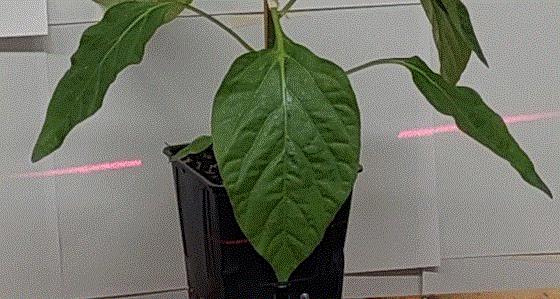Water problems? Water answers!
There’s still time to sign up for Wednesday’s excellent GrowerTalks webinar, which will feature Kurt Becker from Dramm answering all your irrigation water questions. In fact, I’ll bet he’ll tell you things about your irrigation water you didn’t even know to ask!

In the free webinar “Common Water Problems and How to Solve Them,” Kurt will discuss the various common water issues that affect every grower and provide the solution to each problem. If you irrigate your crops with water, you’ll want to attend!
It’s slated for Wednesday, March 11, at 1:00 p.m. Eastern/Noon Central.
Register HERE.
While there, scroll to the “Available Now” section and click on the webinar about Dissolved Oxygen, which was Part 1 of our two-part water series with Dramm. It’s fascinating!
As always, I’ll be your host and emcee, so you know it'll be fast-paced, informative and fun!
Two technologies from abroad
This week, I learned about two advanced technologies for the greenhouse—one that automates the tissue culture process, which could eventually lead to lower-cost TC liners; and one that utilizes lasers for insect control, which could reduce your use of chemical controls. Here are the details I have so far:
An automated TC-propagation machine from Down Under
If you’ve ever been to a tissue culture lab, you know that there's much hand-labor involved in dividing up the meristem cells, putting them in agar, then dividing up the tiny TC plantlets and replanting them in community pots (I think that’s what they’re called) to grow on until they’re finally large enough to plant in soil and put in a greenhouse. That’s a lot of manual labor.
Lowes TC in Tumbi Umbi, Australia (about 60 miles north of Sydney) has been working on the technology for automating the TC process for a decade, and now Greg Lowes tells me he’s sold the company to NXT BioSciences in order to commercialize the technology.
Said Greg, “It is now our goal to change every horticultural industry worldwide that needs clonal high-health propagation.”
Lowes has built prototypes of two machines, “AXAR” for vertical-stem plants and “AXAL” for basal-branching plants. Both AX machines work by taking the TC growing in bioreactors, cuts the plants apart and then places them into more bioreactors for further growth, repeating the process until they have the numbers required, at which time the AX machine will cut the plants a final time, putting them on rooting media in a bioreactor, and after a final few weeks of growth these will be ready for transplanting—presumably by an automatic transplanter.
Both AX machines currently produce between 2,000 and 5,000 plants per hour, reducing their internal tissue culture labor costs by more than 94%, Greg said.

That's the machine back there, behind the security team. If they showed us how it works, they'd have to kill us.
“This is huge, and makes plant tissue culture done this way cheaper than cuttings and URCs,” Greg said. He adds that the next machines they build should be much faster.
They didn’t just have to invent a propagation machine, they also had to reinvent the bioreactors used to produce the tissue culture to have a large opening to allow the machine full access to the bioreactor without negatively impacting contamination rates. The new bioreactors took three years of development work. Lowes TC has applied for multiple patents for these inventions around the world.
I've been hearing about another TC-automation technology coming from Germany. Greg commented on that in his press release, saying, “The only competing machine to ours seems to be the RoboCut from Germany and we believe we have several competitive advantages to that option.”
As for the sale of his company, Greg stated, “All of this research and development took money, and the next step of full commercialization needed a lot more money. NXT BioScience and their investors have come in to supply us with the staff and capital required to commercialize our new technology to the entire industry worldwide.” Greg will stay on as Director of R&D.
“Stand by for big change if you do [plant tissue culture],” he said.
Greg added that he would like to hear from tissue culture labs looking to be involved in the commercialization of the technology. You can email him at greg@lowestc.com.au.

Zapping bugs with lasers
At Wageningen University & Research in the Netherlands, researcher Estuardo “EJ” Hernández Olesinski and his team are seeing if lasers can be used in the greenhouse to kill insect pests. They're delivering the laser light in a triangular shaped “wall of light” that can be installed in the ventilation system of a greenhouse to zap them as they enter, or even used preventatively by actively scanning for pests. The laser does have enough power to burn human skin at the target point of the machine, but it quickly disperses and isn't hazardous within a few meters.
Currently, they're focused on fighting thrips and aphids, which can be killed even when located underneath the leaf. The laser doesn’t harm the plants. They say the system can be “tuned” for different insects, and natural enemies in the greenhouse can remain safe when discriminated based on their size (bigger insects require more energy), making the system as suitable addition to a beneficials program. EJ says there are even opportunities to use lasers in open-field cultivation.

The project— “Lasers In Greenhouses and Horticulture against Thrips and pests” (LIGHT)—is a public-private partnership between Lion Laser Systems, Ekyw, Glastuinbouw Nederland, Octiva, Royal Brinkman, Stichting Kijk, and The Greenhouse Horticulture and Flower Bulbs Business Unit of Wageningen University & Research.

SAF comes to our defense
You never see flower ads that encourage consumers to “Forget the chocolates, buy her roses!” or “Wine? It’ll be gone in an hour. Give a houseplant instead.”
But at Valentine’s Day, and again at Mother’s Day, our beautiful products become an easy target, and the Society of American Florists is always on guard to call out the miscreants who have to knock flowers in order to sell motor oil.
Yes, that’s right, motor oil—a Valvoline ad that said, “Your Valentine doesn’t need flowers, they need an oil change.” That’s just one example of the companies bashing our stuff.
Skincare company OSEA posted a social media ad featuring a vase of flowers accompanied by the text, “Skip the Flowers this Valentine's Day!”
Luxury gift company Ricordami used the headline, “Why get her flowers that will die in a week? Make it a memorable Valentine’s Day with our heart-warming Rose Bear.”
Klarna, a financial tech company, ran email and social media promotions advertising a variety of products with the headline, “Valentine’s Season is here. Do better than flowers.”
Gertrude Hawk Chocolates sent email promotions with the headline, “Forget the Flowers. Choose chocolate.”
Online retailer 40 Boxes sent text messages to advertise their Valentine’s Day sale with the copy, “40 Boxes: Better than Roses … Get 70% off our collection.”
Popular stationery, photo and gift retailer Shutterfly sent a promotional text message that read “Flowers? For Valentines? Groundbreaking. Let them feel the love this year with a unique gift instead!”
Rogers & Holland Jewelers ran a radio ad that stated, “Roses are red, violets are blue, roses die in a day or two.”
Southwest Airlines promoted a spring travel sale at Valentine's Day with the subject line, “$49 sale. Even better than roses.”
SAF reached out to each of these companies. One response, from OSEA, acknowledged the concerns raised by SAF: “Our Valentine’s Day post was based on many factors and this was not our intention. I want you to know I will send your concerns and feedback to the appropriate team. We appreciate hearing from our others as we continue to grow our family business.”

APHIS wants your thoughts on Ralstonia protocols
The U.S. Department of Agriculture’s (USDA) Animal & Plant Health Inspection Service (APHIS) requests comment on an updated draft framework of requirements for facilities that export plants (namely geraniums) to the U.S. that can be hosts of the viral disease Ralstonia solanacearum race 3 biovar 2.
For those who don’t know, this strain of Ralstonia is on what's known as the USDA “bioterrorism list” because it poses a threat to the potato industry. Its primary hosts are Pelargonium spp. (geranium), as well as plants in the genus Solanum, which includes tomatoes and potatoes.
In 2007, after serious outbreaks in 1999 and 2003, APHIS released a new protocol called “Minimum Sanitation Protocol for Offshore Geranium Cutting Production.” It hasn't been updated since then, and APHIS said that detection and suspect detections in 2020, 2021 and 2023 demonstrate the need to update the protocol. They hope to close sanitation and testing gaps, and clarify the roles and responsibilities of the program participants. And they’ll update the standard operating procedures for if and when Ralstonia is detected.
You can read and review the new draft framework HERE. And then send your comments to ppq.nappra@aphis.usda.gov.
The comment period closes April 5, 2024.

USDA expands insurance options for nursery growers
Here’s some good news from AmericanHort’s Craig Regelbrugge and Rachel Pick: The USDA’s Risk Management Agency (RMA) is expanding the Nursery Value Select (NVS) crop insurance program to all counties in all states, offering nursery producers to select coverage amounts suited to their risk management needs. NVS has been operating since 2021 as a limited pilot, with the encouragement of AmericanHort and state industry association partners such as the Florida Nursery, Growers & Landscape Association (FNGLA).
According to USDA, the resulting NVS offers improved coverage compared to the Nursery Field Grown and Container (FG&C) program, covering field-grown and containerized nursery plants with coverage levels between catastrophic and 75%.
Previously available in select counties in nine states, NVS will now be accessible nationwide starting with the 2025 crop year. The sales closing date for 2025 is May 1, 2024, or September 1, 2024.
More information can be found HERE or by contacting your RMA regional office.
Finally ...
I can't believe we're just a a few weeks from starting the annual Spring Sales Survey, which I always kick off at the end of March/beginning of April. In fact, this year, Easter is that weekend, so it could be an important one. And with the wild, warm weather some places have been experiencing, it may already be spring. And as I think I told you, I now live in Orlando, Florida, where it's been spring since I arrived in December.
All that to ask, How's it going so far? If you're down South or out West, how is Spring '24 thus far? Or if you're in a place where it's not yet spring, has spring sprung early?
Weigh in HERE. You can even give Spring '24 a score on our 1-to-10 scale if you like. Just tell me where you're doing business.
Feel free to email me at beytes@growertalks.com if you have ideas, comments or questions.
See you next time!

Chris Beytes
Editor-in-Chief
GrowerTalks and Green Profit
This e-mail received by 27,293 loyal readers!
Thanks to my loyal sponsors, who help me reach the 27,293 readers of Acres Online in more than 60 countries. Want to be one of them (a sponsor, that is)? Give Kim Brown a shout and she will tell you about our many advertising opportunities.